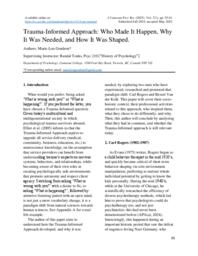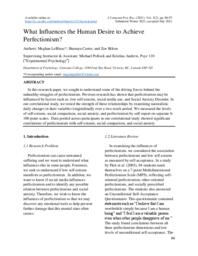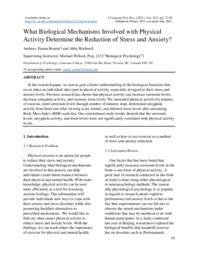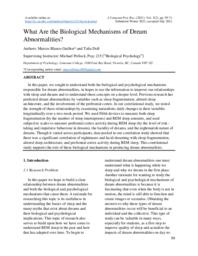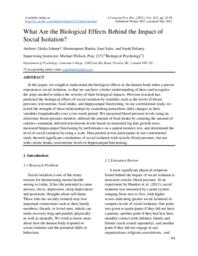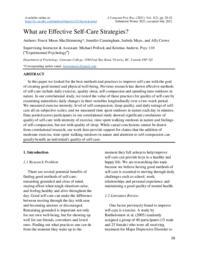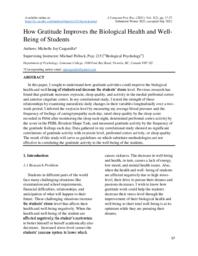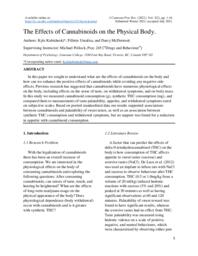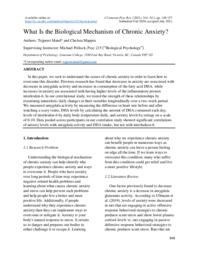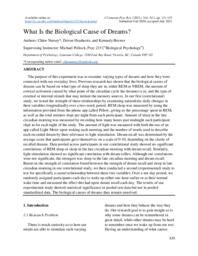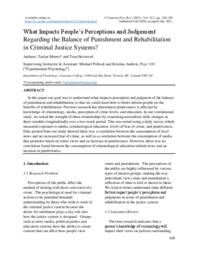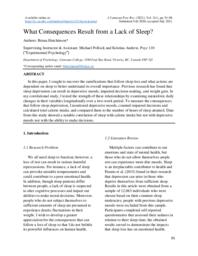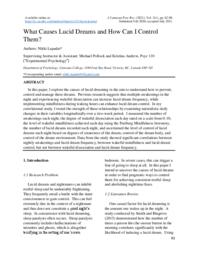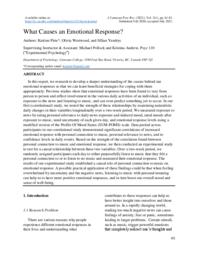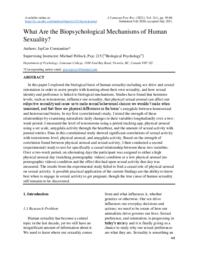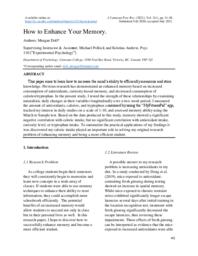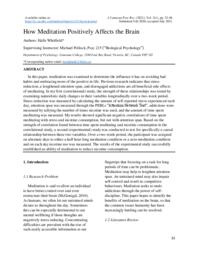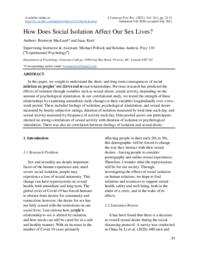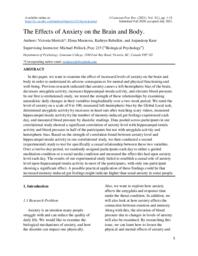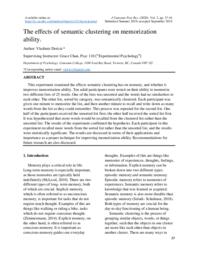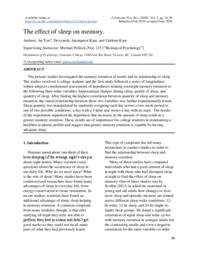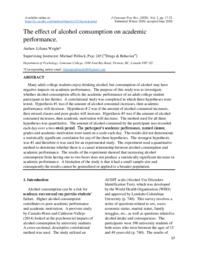article
Related Works
Content type
Digital Document
Origin Information
Content type
Digital Document
Origin Information
Content type
Digital Document
Origin Information
Content type
Digital Document
Description / Synopsis
In this research paper, we sought to understand some of the driving forces behind the unhealthy struggles of perfectionism. Previous research has shown that perfectionism may be influenced by factors such as: low self-esteem, social media use, and Social Anxiety Disorder. In our correlational study, we tested the strength of these relationships by examining naturalistic daily changes in their variables longitudinally over a two-week period. We measured the levels of self-esteem, social comparison, social anxiety, and perfectionism by self-report on separate 0-100 point scales. Data pooled across participants in our correlational study showed significant correlations of perfectionism with self-esteem, social comparison, and social anxiety.
Origin Information
Content type
Digital Document
Description / Synopsis
In this research paper, we aim to gain a better understanding of the biological functions that occur when an individual takes part in physical activity, especially in regard to their stress and anxiety levels. Previous research has shown that physical activity can increase serotonin levels, decrease amygdala activity, and increase irisin levels. We measured physical activity by minutes of exercise, rated serotonin levels through number of minutes slept, determined amygdala activity from heart rate after viewing scary stimuli, and inferred irisin levels after measuring Body Mass Index (BMI) each day. Our correlational study results showed that the serotonin levels, amygdala activity, and irisin levels were not significantly correlated with physical activity levels.
Origin Information
Content type
Digital Document
Description / Synopsis
In this paper, we sought to understand both the biological and psychological mechanisms responsible for dream abnormalities, in hopes to use the information to improve our relationships with sleep and dreams and to understand these concepts on a deeper level. Previous research has predicted dream abnormalities by variables such as sleep fragmentation, altered sleep architecture, and the involvement of the prefrontal cortex. In our correlational study, we tested the strength of these relationships by examining naturalistic daily changes in their variables longitudinally over a two-week period. We used Fitbit devices to measure both sleep fragmentation (by the number of sleep interruptions) and REM sleep amounts, and used subjective scales to measure prefrontal cortex activity during REM sleep (by the level of risk-taking and impulsive behaviour in dreams), the lucidity of dreams, and the nightmarish nature of dreams. Though it varied across participants, data pooled in our correlation study showed that there was a significant correlation of nightmares and lucid dreaming with sleep fragmentation, altered sleep architecture, and prefrontal cortex activity during REM sleep. This correlational study supports the role of these biological mechanisms in producing dream abnormalities.
Origin Information
Content type
Digital Document
Description / Synopsis
In this paper, we sought to understand the biological effects in the human body when a person experiences social isolation, so that we can have a better understanding of these and recognize the steps needed to reduce the severity of their biological impacts. Previous research has predicted the biological effects of social isolation by variables such as the levels of blood pressure, testosterone, food intake, and hippocampal functioning. In our correlational study, we tested the strength of these relationships by examining naturalistic daily changes in their variables longitudinally over a two-week period. We measured blood pressure levels using an electronic blood pressure monitor, inferred the amount of food intake by counting the amount of calories consumed, inferred testosterone levels based on measured leg hair growth rates, measured hippocampal functioning by performance on a spatial memory test, and determined the level of social isolation by using a scale. Data pooled across participants in our correlational study showed significant correlations of social isolation with systolic blood pressure, but not with calorie intake, testosterone levels or hippocampal functioning.
Origin Information
Content type
Digital Document
Description / Synopsis
In this paper we looked for the best methods and practices to improve self-care with the goal of creating good mental and physical well-being. Previous research has shown effective methods of self-care include daily exercise, quality sleep, self-compassion and spending time outdoors in nature. In our correlational study, we tested the value of these practices for quality of self-care by examining naturalistic daily changes in their variables longitudinally over a two-week period. We measured exercise intensity, level of self-compassion, sleep quality, and daily ratings of self-care all on subjective scales, and we measured time spent outdoors in nature each day in minutes. Data pooled across participants in our correlational study showed significant correlations of quality of self-care with intensity of exercise, time spent walking outdoors in nature and feelings of self-compassion, but not with quality of sleep. While causal conclusions cannot be drawn from correlational research, our work does provide support for claims that the addition of moderate exercise, time spent walking outdoors in nature and attention to self-compassion can greatly benefit an individual's quality of self-care.
Origin Information
Content type
Digital Document
Description / Synopsis
In this paper, I sought to understand how gratitude activities could improve the biological health and well-being of students and decrease the students’ stress-level. Previous research has found that gratitude increases oxytocin, sleep quality, and activity in the medial prefrontal cortex and anterior cingulate cortex. In my correlational study, I tested the strength of these relationships by examining naturalistic daily changes in their variables longitudinally over a two-week period. I inferred the oxytocin level by measuring my average blood pressure and the frequency of feelings of caring/sympathy each day, rated sleep quality by the sleep score recorded in Fitbit after monitoring the sleep each night, determined prefrontal cortex activity by the score in the PEBL Bivalent Shape Task, and measured gratitude activity by the frequency of the gratitude feelings each day. Data gathered in my correlational study showed no significant correlations of gratitude activity with oxytocin level, prefrontal cortex activity, or sleep quality. The result of this study will serve as guidelines on which substitute methodologies are not effective in correlating the gratitude activity to the well-being of the students.
Origin Information
Content type
Digital Document
Description / Synopsis
In this paper we sought to understand what are the effects of cannabinoids on the body and how can we enhance the positive effects of cannabinoids while avoiding any negative side effects. Previous research has suggested that cannabinoids have numerous physiological effects on the body, including effects on the sense of taste, on withdrawal symptoms, and on body mass. In this study we measured cannabinoid consumption (g), synthetic THC consumption (mg), and compared them to measurements of taste palatability, appetite, and withdrawal symptoms rated on subjective scales. Based on pooled standardized data our results supported associations between cannabinoids and palatability of sweet tastes, as well as an association between synthetic THC consumption and withdrawal symptoms, but no support was found for a reduction in appetite with cannabinoid consumption.
Origin Information
Content type
Digital Document
Description / Synopsis
In this paper, we seek to understand the causes of chronic anxiety in order to learn how to overcome this disorder. Previous research has found that decreases in anxiety are associated with decreases in amygdala activity and increases in consumption of the fatty acid DHA, while increases in anxiety are associated with having higher levels of the inflammatory protein interleukin-6. In our correlational study, we tested the strength of these relationships by examining naturalistic daily changes in their variables longitudinally over a two-week period. We measured amygdala activity by measuring the difference in heart rate before and after watching a scary video, DHA levels by calculating the amount of DHA consumed each day, levels of interleukin-6 by daily body temperature daily, and anxiety levels by ratings on a scale of 0-10. Data pooled across participants in our correlation study showed significant correlations of anxiety levels with amygdala activity and DHA intake, but not with interlueken-6.
Origin Information
Content type
Digital Document
Description / Synopsis
The purpose of this experiment was to examine varying types of dreams and how they were connected with our everyday lives. Previous research has shown that the biological causes of dreams can be based on what type of sleep they are in, either REM or NREM, the amount of cortical activation caused by what point of the circadian cycle the dreamer is in, and the type of external or internal stimuli that may initiate the memory sources. In our first (correlational) study, we tested the strength of these relationships by examining naturalistic daily changes in their variables longitudinally over a two-week period. REM sleep was measured by using the information provided from the phone app called Pillow, giving us the percentage spent in REM, as well as the total minutes slept per night from each participant. Amount of sleep in the late circadian morning was measured by recording how many hours past midnight each participant slept in for each night of the study. The amount of light was measured with both the use of an app called Light Meter upon waking each morning and the number of words used to describe each recorded dream by their relevance to light stimulation. Dream recall was determined by the average score that participants gave themselves on a scale of 0-10, depending on the clarity of recalled dreams. Data pooled across participants in our correlational study showed no significant correlations of REM sleep or sleep in the late circadian morning with dream recall. Similarly, light stimulation showed no significant correlation with dream tallies. Although our correlations were not significant, the strongest was sleep in the late circadian morning and dream recall. Based on the strength of correlation found between the strength of dream recall and sleep in late circadian morning in our correlational study, we then conducted a second (experimental) study to test for specifically a causal relationship between these two variables. Over a ten-day period, we randomly assigned participants each day to wake up either one hour earlier or at their normal wake time and measured the effect this had upon dream recall each day. The results of our experimental study showed statistical significance in pooled raw data but not in pooled standardized data. The biological causes of dreams thus remain unsolved.
Origin Information
Content type
Digital Document
Description / Synopsis
In this paper our goal was to understand what impacts perception and judgment of the balance of punishment and rehabilitation so that we could learn how to better inform people on the benefits of rehabilitation. Previous research has determined punitiveness is affected by knowledge of criminology, media, perception of crime levels, and education. In our correlational study, we tested the strength of these relationships by examining naturalistic daily changes in their variables longitudinally over a two-week period. This was tested using a daily survey which measured exposure to media, criminological education, levels of fear of crime, and punitiveness. Data pooled from our study showed there was a correlation between the consumption of local news and an increased fear of crime, as well as a correlation between the consumption of media that promotes harsh on crime views and an increase in punitiveness. However, there was no correlation found between the consumption of criminological education tabloid news and an increase in punitiveness.
Origin Information
Content type
Digital Document
Description / Synopsis
In this paper, I sought to uncover the ramifications that follow sleep loss and what actions are dependent on sleep to better understand its overall importance. Previous research has found that sleep deprivation can result in depressive moods, impaired decision-making, and weight gain. In my correlational study, I tested the strength of these relationships by examining naturalistic daily changes in their variables longitudinally over a two-week period. To measure the consequences that follow sleep deprivation, I monitored depressive moods, counted impaired decisions and calculated total calorie intake, and compared them to the number of hours of sleep attained. Data from this study showed a notable correlation of sleep with calorie intake but not with depressive moods nor with the ability to make decisions.
Origin Information
Content type
Digital Document
Description / Synopsis
In this paper, I explore the causes of lucid dreaming in the aim to understand how to prevent, control and manage these dreams. Previous research suggests that multiple awakenings in the night and experiencing wakeful dissociation can increase lucid dream frequency, while implementing mindfulness during waking hours can enhance lucid dream control. In my correlational study, I tested the strength of these relationships by examining naturalistic daily changes in their variables longitudinally over a two-week period. I measured the number of awakenings each night, the degree of wakeful dissociation each day rated on a scale from 0-10, the level of wakeful mindfulness achieved each day using the Freiburg Mindfulness Inventory, the number of lucid dreams recorded each night, and ascertained the level of control of lucid dreams each night based on degrees of awareness of the dream, control of the dream body, and control of the dream environment. Data from the study showed significant correlations between nightly awakenings and lucid dream frequency, between wakeful mindfulness and lucid dream control, but not between wakeful dissociation and lucid dream frequency.
Origin Information
Content type
Digital Document
Description / Synopsis
In this report, we research to develop a deeper understanding of the causes behind our emotional responses so that we can learn beneficial strategies for coping with them appropriately. Previous studies show that emotional responses have been found to vary from person to person and reflect involvement in the various daily activities of an individual, such as exposure to the news and listening to music, and can even predict something yet to occur. In our first (correlational) study, we tested the strength of these relationships by examining naturalistic daily changes in their variables longitudinally over a two-week period. We measured exposure to news by rating personal relevance to daily news exposure and induced mood, rated moods after exposure to music, rated uncertainty of each given day, and emotional response levels using a modified version of the Profile Of Mood States (SUM-POMS) scale. Data pooled across participants in our correlational study demonstrated significant correlations of increased emotional response with personal connection to music, personal relevance to news, and to confidence levels in daily events. Based on the strength of the correlation found between personal connection to music and emotional response, we then conducted an experimental study to test for a causal relationship between these two variables. Over a two-week period, we randomly assigned participants each day to either purposefully listen to music that they felt a personal connection to or to listen to no music and measured their emotional response. The results of our experimental study established a causal role of personal connection to music on emotional response. A possible practical application of these findings could be that when feeling overwhelmed by uncertainty and the negative news, listening to music with personal meaning can help us to have more positive emotional responses, and in turn boost our overall mood and sense of well-being.
Origin Information
Content type
Digital Document
Description / Synopsis
In this paper I explored the biological basis of human sexuality including sex drive and sexual orientation in order to assist people with learning about their own sexuality, and how sexual identity and preference is linked to biological mechanisms. Studies have found that hormone levels, such as testosterone, influence our sexuality, that physical sexual arousal can affect our subjective sexuality and cause us to make sexual behavioural choices we wouldn’t make when unaroused, and that there are physical differences in the brain’s amygdala between homosexual and heterosexual brains. In my first (correlational) study, I tested the strength of these relationships by examining naturalistic daily changes in their variables longitudinally over a two-week period. I measured the level of testosterone using a period tracking app, physical arousal using a set scale, amygdala activity through the heartbeat, and the amount of sexual activity with journal entries. Data in this correlational study showed significant correlations of sexual activity with testosterone level, physical arousal, and amygdala activity. Based on the strength of correlation found between physical arousal and sexual activity, I then conducted a second (experimental) study to test for specifically a causal relationship between these two variables. Over a two-week period, on alternating days the participant was assigned to either a high physical arousal day (watching pornographic videos) condition or a low physical arousal (no pornographic videos) condition and the effect this had upon sexual activity that day was measured. The results from the experimental study failed to find a causal role of physical arousal on sexual activity. A possible practical application of the current findings are the ability to know best when to engage in sexual activity to get pregnant, though the true cause of human sexuality still remains to be discovered.
Origin Information
Content type
Digital Document
Description / Synopsis
This paper aims to learn how to increase the mind’s ability to efficiently memorize and store knowledge. Previous research has demonstrated an enhanced memory based on increased consumption of antioxidants, curiosity-based memory, and decreased consumption of calories/tryptophan. In the present study, I tested the strength of these relationships by examining naturalistic daily changes in their variables longitudinally over a two-week period. I measured the amount of antioxidants, calories, and tryptophan consumed by using the “MyFitnessPal” app, tracked my interest in daily studies on a scale of 1-10, and assessed memory ability using the Match to Sample test. Based on the data produced in this study, memory showed a significant negative correlation with caloric intake, but no significant correlation with antioxidant intake, curiosity level, or tryptophan intake. To summarize the practical applications of my findings it was discovered my caloric intake played an important role in solving my original research problem of enhancing memory and being a more efficient student.
Origin Information
Content type
Digital Document
Description / Synopsis
In this paper, meditation was examined to determine the influence it has on avoiding bad habits and embracing more of the positive in life. Previous research indicates that stress reduction, a lengthened attention span, and disengaged addictions are all beneficial side effects of meditating. In my first (correlational) study, the strength of these relationships was tested by examining naturalistic daily changes in their variables longitudinally over a two-week period. Stress reduction was measured by calculating the amount of self-reported stress experienced each day, attention span was measured through the PEBLs “Attention Network Test”, addictions were measured by tallying the number of times nicotine was used, and the amount of time spent meditating was measured. My results showed significant negative correlations of time spent meditating with stress and nicotine consumption, but not with attention span. Based on the strength of correlation found between time spent meditating and nicotine consumption in the correlational study, a second (experimental) study was conducted to test for specifically a causal relationship between these two variables. Over a two-week period, the participant was assigned on alternate days to either a half hour long meditation condition or a zero-meditation condition and on each day nicotine use was measured. The results of the experimental study successfully established an ability of meditation to reduce nicotine consumption.
Origin Information
Content type
Digital Document
Description / Synopsis
In this paper, we sought to understand the short- and long-term consequences of social isolation on peoples’ sex drives and sexual relationships. Previous research has predicted the effects of isolation through variables such as sexual desire, sexual activity, depending on the amount of psychological stimulation. In our correlational study, we tested the strength of these relationships by examining naturalistic daily changes in their variables longitudinally over a two-week period. These included feelings of isolation, psychological stimulation, and sexual desire measured by hourly subjective ratings, duration of isolation measured by total time each day, and sexual activity measured by frequency of activity each day. Data pooled across our participants showed no strong correlations of sexual activity with duration of isolation or psychological stimulation. There was also no correlation between feelings of isolation and sexual desire.
Origin Information
Content type
Digital Document
Description / Synopsis
In this paper, we want to examine the effect of increased levels of anxiety on the brain and body in order to understand its adverse consequences for mental and physical functioning and well-being. Previous research indicated that anxiety causes a left-hemispheric bias of the brain, decreases amygdala activity, increases hippocampal-insula activity, and elevates blood pressure. In our first (correlational) study, we tested the strength of these relationships by examining naturalistic daily changes in their variables longitudinally over a two-week period. We rated the level of anxiety on a scale of 0 to 100, measured left-hemispheric bias by the Global Local task, determined amygdala activity by increases in heart rate after watching scary videos, measured hippocampal-insula activity by the number of memory-induced gut feelings experienced each day, and measured blood pressure by diastolic readings. Data pooled across participants in our correlational study showed a significant correlation of anxiety level with hippocampal-insula activity and blood pressure in half of the participants but not with amygdala activity and hemispheric bias. Based on the strength of correlation found between anxiety level and hippocampal-insula activity in our correlational study, we then conducted a second (experimental) study to test for specifically a causal relationship between these two variables. Over a twelve-day period, we randomly assigned participants each day to either a guided meditation condition or a social media condition and measured the effect this had upon anxiety level each day. The results of our experimental study failed to establish a causal role of anxiety level upon hippocampal-insula activity in most of the participants, with only one participant showing a significant effect. A possible practical application of these findings could be that increased memory-induced gut feelings might indicate higher than usual anxiety in some people.
Origin Information
Content type
Digital Document
Description / Synopsis
This experiment examined the effects semantic clustering has on memory, and whether it improves memorization ability. Ten adult participants were tested on their ability to memorize two different lists of 25 words. One of the lists was unsorted and the words had no similarities to each other. The other list, sorted by category, was semantically clustered. Each participant was given one minute to memorize the list, and then another minute to recall and write down as many words from the list as they could remember. This process was repeated for the second list. One half of the participants received the unsorted list first; the other half received the sorted list first. It was hypothesized that more words would be recalled from the clustered list rather than the unsorted list. The results of the experiment confirmed the hypothesis. Each participant in this experiment recalled more words from the sorted list rather than the unsorted list, and the results were statistically significant. The results are discussed in terms of their applications and importance as a proper technique for improving memorization ability. Recommendations for future research are also discussed.
Origin Information
Content type
Digital Document
Description / Synopsis
The present studies investigated the memory retention of words and its relationship to sleep. The studies involved 4 college students and the first study followed a series of longitudinal within-subjects correlational assessments of hypotheses relating overnight memory retention to the following three other variables: hippocampal changes during sleep, quality of sleep, and quantity of sleep. After finding the highest correlation between quantity of sleep and memory retention, the causal relationship between these two variables was further experimentally tested. Sleep quantity was manipulated by randomly assigning each day across a two-week period to one of two possible conditions: a day with a 3-hour nap versus a day with no naps. The results of the experiment supported the hypothesis that increases in the amount of sleep result in a greater memory retention. These results are of importance for college students in maintaining a healthier academic profile and suggest that greater memory retention is capable by having adequate sleep.
Origin Information
Content type
Digital Document
Description / Synopsis
Many adult college students enjoy drinking alcohol, but consumption of alcohol may have negative impacts on academic performance. The purpose of this study was to investigate whether alcohol consumption affects the academic performance of an adult college student participant in her thirties. A correlational study was completed in which three hypotheses were tested. Hypothesis #1 was if the amount of alcohol consumed increases, then academic performance will decrease. Hypothesis # 2 was if the amount of alcohol consumed increases, then missed classes and poor grades will increase. Hypothesis #3 was if the amount of alcohol consumed increases, then academic motivation will decrease. The method used for all three hypotheses was quantitative. The amount of alcohol consumed by the participant was recorded each day over a two-week period. The participant’s academic performance, missed classes, grades and academic motivation were rated on a scale each day. The results did not demonstrate a statistically significant correlation for any of the three hypotheses. The strongest hypothesis was #1 and therefore it was used for an experimental study. The experiment used a quantitative method to determine whether there is a causal relationship between alcohol consumption and academic performance. The results of the experiment showed that increasing alcohol consumption from having one to two beers does not produce a statistically significant decrease in academic performance. A limitation of the study is that it had a small sample size and consequently the results cannot be generalized or applied to a broader population.
Origin Information
